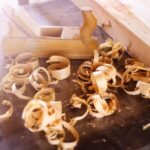Woodwork can bring warmth and elegance to any space, but when water stains appear, they can quickly become an eyesore. Knowing how to remove water stains from woodwork is essential in order to restore its beauty and maintain its integrity. In this article, we will explore the various types of water stains that can affect woodwork, and provide step-by-step instructions on removing them effectively.
Water stains on woodwork are caused by the penetration of liquids into the porous surface of the wood. Whether it’s a spill from a glass, a leaky roof, or excess moisture in a humid environment, these stains can mar the appearance and even compromise the structural stability of the wood if left unaddressed. It is important to tackle water stains promptly to prevent further damage and restore the original condition of your woodwork.
To start off, it is crucial to identify the type of water stain you are dealing with. There are two main types: white water stains and black water stains. White water stains typically occur when moisture penetrates the surface finish of the wood, leaving behind a cloudy or hazy area.
On the other hand, black water stains result from prolonged exposure to standing or stagnant water, which attracts mold or mildew growth. Understanding the type of stain you have will determine the most appropriate removal method.
In the following sections of this article, we will delve into quick and easy DIY remedies for removing water stains using common household items such as vinegar, baking soda, and toothpaste. We will also discuss professional-grade products available in the market specifically designed for removing these stubborn marks from woodwork. Additionally, we will explore sanding and refinishing techniques for deep-seated stains and provide tips on preventing future water damage.
By taking proactive steps to address water stains on your woodwork promptly and effectively, you can preserve its beauty and prolong its lifespan. Let’s dive deeper into each aspect of tackling these unsightly blemishes and restore your woodwork to its former glory.
Identifying the type of water stain
Water stains on woodwork can be unsightly and may even lead to further damage if not addressed promptly. Before attempting any removal methods, it is important to identify the type of water stain present. This will help determine the appropriate course of action for effective removal.
One common type of water stain is the white water stain, also known as a “blush.” These stains occur when moisture penetrates the finish of the wood and creates a cloudy or milky discoloration. White water stains are typically less severe and easier to remove compared to black water stains.
On the other hand, black water stains are more deeply set into the wood and often require more intensive treatment for removal. These stains occur when water seeps beyond the finish and into the actual wood fibers, resulting in a dark discoloration. Black water stains can be particularly stubborn and may require sanding or refinishing to completely eliminate.
To determine whether a stain is white or black, simply wipe a small amount of denatured alcohol onto an inconspicuous area of the stained surface using a clean cloth. If the stain disappears or becomes less visible, it is likely a white water stain. If there is no change in appearance, it is likely a black water stain.
Once you have identified the type of water stain, you can proceed with selecting the most suitable method for removal. For white water stains, simple remedies like vinegar or toothpaste can be highly effective. On the other hand, black water stains may require more aggressive approaches such as sanding and refinishing.
In summary, identifying whether a water stain is white or black is crucial in determining how to approach its removal. By understanding these distinctions and following appropriate techniques, you can successfully eliminate unsightly water stains from your woodwork.
| Water Stain Type | Description | Removal Method |
|---|---|---|
| White Water Stain | Cloudy or milky discoloration on the wood surface | Vinegar, toothpaste, or other household remedies |
| Black Water Stain | Dark discoloration deeply set into the wood fibers | Sanding and refinishing may be required |
Quick and easy DIY remedies for water stain removal
When it comes to removing water stains from woodwork, there are several quick and easy DIY remedies that can be effective. These remedies often involve utilizing common household items such as vinegar, baking soda, and toothpaste. By following some simple step-by-step instructions, you can effectively remove water stains from your woodwork without having to invest in expensive products or professional help.
Using Vinegar
Vinegar is a versatile household ingredient that can be used for various cleaning purposes, including removing water stains from woodwork. To use vinegar for stain removal, start by dampening a clean cloth with white vinegar. Gently rub the stained area in circular motions until the stain starts to fade away. You may need to repeat this process a few times for stubborn stains. Once the stain is removed, wipe down the area with a clean damp cloth and dry thoroughly.
Baking Soda Paste
Another effective DIY remedy for water stain removal is using a baking soda paste. Start by mixing equal parts of baking soda and water to create a thick paste. Apply the paste directly onto the stained area and let it sit for about 15 minutes. Afterward, gently scrub the area with a soft bristle brush or toothbrush in circular motions. Rinse off the paste with clean water and dry thoroughly.
Toothpaste Trick
Toothpaste is not only good for oral hygiene but can also be used to remove water stains from woodwork. Ensure that you are using non-gel toothpaste without any added ingredients like whitening agents or gels. Apply a small amount of toothpaste onto the stained area and gently rub it in circular motions using a soft cloth or sponge.
Keep rubbing until the stain starts lifting off. Once done, wipe off any residue with a clean damp cloth and dry thoroughly.
By utilizing these quick and easy DIY remedies, you can effectively remove water stains from your woodwork without much hassle. However, it is important to note that these remedies may not be suitable for all types of wood or certain stubborn stains. In such cases, it may be necessary to explore other options like professional-grade products or sanding and refinishing techniques.
Professional-grade products for water stain removal
When it comes to removing water stains from woodwork, sometimes household remedies may not be enough. In such cases, professional-grade products specifically designed for water stain removal can be highly effective. These commercial wood cleaners and stain removers are formulated with powerful ingredients that can penetrate deep into the wood and lift stubborn stains.
1. Overview of commercial wood cleaners and stain removers:
There are numerous products available in the market that claim to effectively remove water stains from woodwork. It is important to select a product that is suitable for the type of stain you are dealing with and compatible with the specific type of woodwork you have. Before using any product, carefully read the instructions and follow them diligently.
2. Evaluating effectiveness and suitability:
Different commercial products may have different levels of effectiveness depending on the severity of the water stain and the condition of the woodwork. It is advisable to do a patch test on a small, inconspicuous area before applying the product on the entire stained surface. This will help determine if there are any adverse effects or discoloration caused by the product.
3. Choosing the right product for your needs:
Some products may be better suited for white water stains, while others may cater specifically to black water stains. Depending on your requirements, choose a product that targets your specific type of stain. Additionally, consider factors such as odor and toxicity when selecting a product, especially if you are sensitive to certain chemicals or have pets or children in your home.
Sanding and refinishing woodwork to remove stubborn water stains
Sanding and refinishing woodwork can be an effective method for removing stubborn water stains that have deeply penetrated the surface. When quick and easy DIY remedies or commercial cleaners fail to completely eliminate the water stains, sanding becomes necessary to restore the beauty of the woodwork.
To begin the process, it is important to carefully prepare the damaged area before sanding. Start by thoroughly cleaning the wood surface with a mild soap and water solution to remove any dirt or grime. Once dry, use a fine-grit sandpaper (around 220 grit) to gently sand away the top layer of the stained wood. The goal here is to remove any discolored areas, while being cautious not to damage or gouge the wood.
After sanding, wipe down the area with a clean cloth or tack cloth to remove any dust particles. This step is crucial as it ensures a smooth and even finish when refinishing. If necessary, repeat the sanding process with progressively higher grit sandpaper, such as 320 or 400 grit, until satisfactory results are achieved.
Once the stained area has been sanded down evenly, it is time to refinish and protect the woodwork. Choose a suitable stain or paint that matches your existing finish or desired look. Apply several thin coats of stain using a brush or cloth, following the manufacturer’s instructions for application and drying times. For added protection against future water stains, seal the woodwork with an appropriate sealant or varnish.
Sanding and refinishing woodwork can be a labor-intensive process, especially for larger areas or intricate designs. It is essential to take breaks between sanding sessions to avoid fatigue and ensure careful attention to detail. If you are unsure about tackling this task yourself or dealing with extensive water damage on your woodwork, it may be wise to consult a professional restoration service who can provide expert advice and assistance.
By successfully sanding and refinishing your water-stained woodwork, you can restore its original beauty and extend its lifespan. Regular maintenance and prompt action against signs of water damage will also help prevent future stains and protect your woodwork investment. Remember, patience and attention to detail are key to achieving the best results when removing stubborn water stains through sanding and refinishing.
Preventing future water stains on woodwork
Woodwork can add a touch of elegance and warmth to any space. However, it is important to keep in mind that wood is susceptible to water damage, which can lead to unsightly stains or even permanent damage if not addressed promptly. To prevent future water stains on your woodwork, here are some tips and tricks you can implement:
- Use coasters and mats: One of the easiest ways to prevent water stains on your woodwork is by using coasters or mats. Place them under glasses, vases, and other objects that may leave behind moisture rings or spills. This simple step can go a long way in protecting the natural beauty of your wood surfaces.
- Avoid placing wet items directly on wood: Wet items like damp towels or plant pots should never be placed directly onto wood surfaces. The moisture from these items can seep into the wood and cause stains or discoloration. Always use a protective barrier such as a waterproof tray or a cloth between wet items and your woodwork.
- Apply a sealant or finish: Applying a sealant or finish to your woodwork creates a protective layer that helps repel water and prevents staining. There are various types of sealants available, including polyurethane, varnish, lacquer, and wax. Choose one that is suitable for your specific type of woodwork and follow the manufacturer’s instructions for application.
- Clean up spills immediately: Accidents happen, but it’s crucial to clean up spills on your woodwork as soon as they occur. Use a clean cloth or paper towel to blot away any liquid without rubbing it into the surface. Prompt action can minimize the chances of water penetrating the wood fibers and causing permanent damage.
- Control humidity levels: Excessive moisture in the air can also lead to water stains on your woodwork. Investing in a dehumidifier or using a moisture absorber can help control humidity levels and prevent condensation from forming on your wood surfaces. This is especially important in high-humidity areas such as basements or bathrooms.
By following these preventive measures, you can significantly reduce the risk of water stains on your woodwork and maintain its beauty for years to come. Remember that prevention is always better than restoration when it comes to protecting your hardwood surfaces.
Hiring a professional for water stain restoration
When it comes to severe or extensive water stains on woodwork, it may be necessary to seek the assistance of a professional for restoration. Hiring a professional can ensure that the stains are properly addressed and that the woodwork is restored to its original condition. Here are some key considerations when hiring a professional for water stain restoration:
- Assessing the severity of the damage: Before hiring a professional, it’s important to assess the extent of the water stains on your woodwork. If the stains are superficial and can be easily removed through DIY remedies or commercial cleaners, it may not be necessary to hire a professional. However, if the stains are deep, extensive, or have caused structural damage to the woodwork, it’s best to consult with experts.
- Finding a reputable woodwork restoration service: When searching for professionals in water stain restoration, it’s essential to do thorough research and find a reputable service provider. Look for companies or individuals with experience in handling similar projects and check their customer reviews and ratings. Additionally, consider asking for recommendations from friends, family, or local woodworking organizations.
- Understanding the restoration process: Before hiring a professional, it’s beneficial to have an understanding of the restoration process they will follow. A reliable professional should be able to provide you with detailed information about their methods and techniques for removing water stains from woodwork. They should also communicate any potential challenges or limitations associated with your specific situation.
By hiring a professional for water stain restoration, you can ensure that your woodwork is in good hands and that any damages caused by water stains are effectively repaired. Their expertise and knowledge will help minimize further damage and preserve the beauty of your woodwork.
| Considerations | Tips |
|---|---|
| Assessing Severity | – Assess extent of water stains before hiring a professional.
|
| Reputable Restoration Service | – Research and find a reputable service provider.
|
| Understanding the Process | – Understand the restoration process followed by the professional.
|
Maintenance and care tips for preserving woodwork
Woodwork requires regular maintenance and care to preserve its beauty and protect it from water stains. By following some simple practices, you can ensure that your woodwork remains in good condition for years to come. Here are some maintenance and care tips to help you prevent water stains and prolong the lifespan of your woodwork:
- Regular cleaning: Dust and dirt can accumulate on wood surfaces, making them more prone to water damage. It is important to regularly clean your woodwork using a soft cloth or duster to remove any loose particles. Avoid using harsh chemicals or abrasive cleaners that can damage the finish.
- Use coasters and mats: Water rings can form when glasses or containers are placed directly on wooden surfaces without any protection. To prevent this, always use coasters or mats underneath hot or cold beverages, pots, pans, or any other items that may cause condensation.
- Apply sealant: Adding a sealant to your woodwork can provide an extra layer of protection against water stains. There are several types of sealants available, including polyurethane, wax, or oil-based products. Choose the one that is suitable for your specific type of woodwork and follow the manufacturer’s instructions for application.
- Maintain humidity levels: High humidity can cause wood to absorb moisture from the air, leading to warping or swelling. On the other hand, low humidity can cause the wood to dry out and potentially crack. Use a humidifier or dehumidifier to maintain ideal humidity levels (around 40-50%) in your home.
- Inspect for leaks: Regularly inspect your plumbing fixtures and pipes for any signs of leaks or dripping water. Fixing these issues promptly will not only prevent water stains but also avoid potential structural damage.
By incorporating these maintenance and care tips into your routine, you can effectively prevent water stains on your woodwork and keep it looking beautiful for years to come. Remember to take immediate action if you notice any signs of water damage to avoid further complications. With proper care, your woodwork will continue to enhance the aesthetic appeal of your space.
Conclusion
In conclusion, water stains on woodwork can be a common and frustrating issue, but with the right knowledge and techniques, they can be effectively removed. It is important to understand what causes water stains and address them promptly to prevent further damage to the wood. By identifying the type of water stain, whether it’s a white or black stain, you can choose the most appropriate removal method.
There are various DIY remedies that can be used to remove water stains from woodwork, such as vinegar, baking soda, and toothpaste. These household items can be easily applied following step-by-step instructions to effectively eliminate water stains. Additionally, there are professional-grade products available in the market specifically designed for removing water stains from wood. These commercial cleaners and stain removers offer convenience and effectiveness depending on the type of woodwork.
For stubborn water stains that cannot be removed with DIY remedies or commercial products, sanding and refinishing may be necessary. Sanding damaged wood surfaces can help remove deep water stains before refinishing techniques are applied. It is essential to choose the appropriate sandpaper grit and refinishing methods to achieve satisfactory results.
To prevent future water stains on woodwork, it is recommended to use coasters, mats, and sealing agents as protective measures against moisture. These simple tips along with regular cleaning and maintenance practices will help prolong the lifespan of your woodwork while preserving its beauty. Remember that immediate action should be taken when signs of water damage appear on your woodwork to prevent further harm.
Frequently Asked Questions
How do you get water stains out of wood finish?
To remove water stains from a wood finish, there are a few methods you can try. One common approach is to gently rub the stain with a mixture of equal parts white vinegar and olive oil. Apply the mixture to the stain using a soft cloth, working it in small circular motions.
Another method is using a non-gel toothpaste or baking soda mixed with water. Gently rub the paste onto the stain and then wipe it off with a damp cloth. Additionally, you can use mayonnaise by applying it directly onto the stain and letting it sit overnight before wiping it away with a clean cloth.
Can water marks be removed from wood?
Yes, water marks can usually be removed from wood surfaces. It will depend on the severity of the stain and how long it has been there, but many water stains are only surface-level and can be remedied with simple techniques.
By using some common household ingredients such as vinegar, olive oil, toothpaste or baking soda mixed with water, or even mayonnaise, you can often successfully remove water marks from wood without damaging its finish.
Are water stains on wood permanent?
Whether water stains on wood are permanent or not depends on various factors such as the type of wood and finish, as well as how long the stain has been left untreated. In some cases, if moisture seeps into the wooden surface for an extended period of time, it may cause irreversible damage to certain types of untreated or unfinished woods.
However, for most finished wood surfaces, especially those coated with protective finishes like varnish or polyurethane, water stains are generally not permanent- they can usually be effectively removed without causing any long-term damage to the wood itself.

Hi everyone! I’m a woodworker and blogger, and this is my woodworking blog. In my blog, I share tips and tricks for woodworkers of all skill levels, as well as project ideas that you can try yourself.





